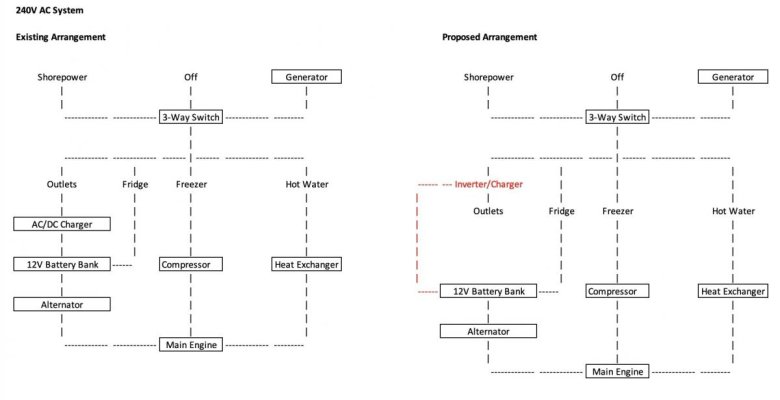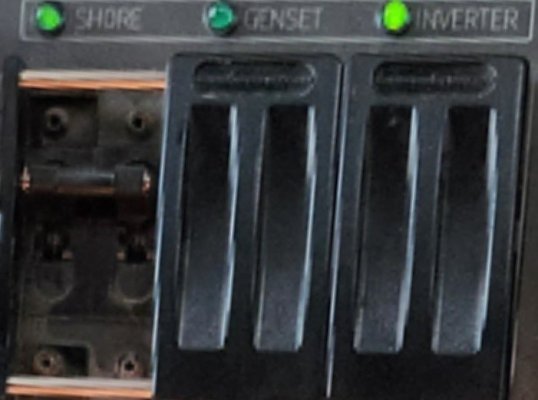Serene
Senior Member
I am looking to add an inverter to an existing system, but am not sure where/how it is wired in with minimal changes.
By way of description I have added a diagram below and will explain here;
1. There is a three-way switch to select AC sources, between shore, generator and off.
2. There are four AC 'loads' which can be individually switched when either shore or generator AC is available. The fridge (12V/240V), freezer (engine/240V) and hot water (engine/240V) all have alternate sources when AC is not available.
3. When either shore or generator are providing AC power, there is an AC/DC charger which is connected to the 12V batteries to charge them, but note this is plugged into one of the multiple 240V AC outlets wired into the boat, so either all outlets + charger are live, or the outlets and charger are all disabled.
Now when I want to add the inverter I am not sure where it gets wired into this system.
Option #1 - Does it get added as an extra 'source'? But then my issue is I can see the 12V batteries providing power to the Inverter which converts it to 240V AC, which then flows back to the outlets and back into the 12V batteries via the AC/DC charger. This will obviously create an issue. But in this scenario the other three AC loads would all be powered with no changes.
Option #2 - Replace the AC/DC charger with an Inverter/Charger, which would charge when AC is present, and invert when it isn't. But in this case how does the AC current flow back to the AC loads? (outlets, fridge, freezer, hot water) And how does an Inverter/Charger know when the AC is coming from shore or generator vs coming back from itself as inverted power?
What is the most elegant way to add an Inverter with minimal change to the existing system?
I don't need the Inverter to power the fridge, freezer or hot water loads, but do want all outlets to be live when inverting. Basically I want access to power lower AC loads via the inverter when not on shore power, without having to start the generator.
Here is the diagram to help understand the situation.
By way of description I have added a diagram below and will explain here;
1. There is a three-way switch to select AC sources, between shore, generator and off.
2. There are four AC 'loads' which can be individually switched when either shore or generator AC is available. The fridge (12V/240V), freezer (engine/240V) and hot water (engine/240V) all have alternate sources when AC is not available.
3. When either shore or generator are providing AC power, there is an AC/DC charger which is connected to the 12V batteries to charge them, but note this is plugged into one of the multiple 240V AC outlets wired into the boat, so either all outlets + charger are live, or the outlets and charger are all disabled.
Now when I want to add the inverter I am not sure where it gets wired into this system.
Option #1 - Does it get added as an extra 'source'? But then my issue is I can see the 12V batteries providing power to the Inverter which converts it to 240V AC, which then flows back to the outlets and back into the 12V batteries via the AC/DC charger. This will obviously create an issue. But in this scenario the other three AC loads would all be powered with no changes.
Option #2 - Replace the AC/DC charger with an Inverter/Charger, which would charge when AC is present, and invert when it isn't. But in this case how does the AC current flow back to the AC loads? (outlets, fridge, freezer, hot water) And how does an Inverter/Charger know when the AC is coming from shore or generator vs coming back from itself as inverted power?
What is the most elegant way to add an Inverter with minimal change to the existing system?
I don't need the Inverter to power the fridge, freezer or hot water loads, but do want all outlets to be live when inverting. Basically I want access to power lower AC loads via the inverter when not on shore power, without having to start the generator.
Here is the diagram to help understand the situation.



